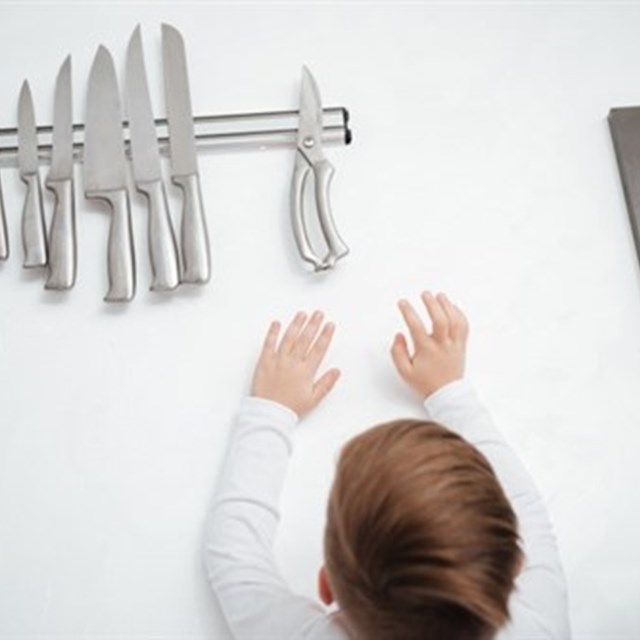
As any new parent or caregiver knows, there is nothing more special than bringing home a new baby. But as safe and secure as a new home may seem, there are many safety dangers hiding in nearly every room of the house. From electrical outlets to cabinets full of cleaning chemicals, here are some things to safeguard against when prepping your home for a little one.
Electrical Outlets and Wires: To ensure your crawling baby or toddler doesn’t get an electric shock, make sure to cover all electric sockets throughout the home with plastic covers, especially the ones within a child’s reach. Also make sure that any appliances or handheld devices do not have worn cords and, if they do, replace them or throw them away. Adults should also stress to a child how important it is to never touch electric items like hair dryers with wet hands and never use near water.
Burns and Scalds: Every year, young children are injured due to a fire or burn—with many accidents happening in the kitchen. To help prevent this, never cook while holding a child. And because kids love to reach, use the back burner of your stove and turn pot handles away from the edge to avoid any hot spills. Outside of potential kitchen accidents, always keep matches, gasoline and lighters in a safe place and out of reach for a curious child.
Water: Speaking of water danger, parents and caretakers should never leave a child alone in the water even for a second—and that includes everything from sinks and bathtubs to kiddie pools and even fountains. Make sure a child knows the dangers of water from the earliest age possible to ensure a lifetime of water safety.
Secure TVs and other heavy furniture: Kids are a lot stronger than they look, and the risk of injury from a TV or furniture tip over or pull down is real. To prevent this risk, make sure all TVs, appliances and furniture are firmly secured with anti-tip brackets, braces or wall straps. You should also install stops on dresser drawers to keep them from being pulled out by a child.
Detergents, laundry packets, cleaning products and medicines: In 2017, there were 10,585 calls to poison centers around the country related to laundry packet incidents involving young children. The problem is they have a candy like appearance and look like a treat to a young child. Make sure to keep packets out of children’s reach and sight, ideally in a closed, original container. Also make sure that all other detergents and cleaning products are safely locked away and up high where children cannot reach them (and never store them in a food container or on kitchen shelves). If any of the items are in a lower cabinet, make sure there is a secure, childproof latch on the door.
When it comes to medicines, be sure to keep them out of reach and sight of children—and not just prescription meds. Keep vitamins and items like diaper rash ointment, eye drops and other products far away from little hands too.
Sleep Safety: It’s a sad fact that unintentional suffocation is the leading cause of injury-related death among children under 1 year of age. Nearly three-quarters of suffocation deaths among infants are from accidental suffocation or strangulation in bed. To help prevent this, make sure that a child’s crib is bare as possible because soft pillows, stuffed animals or dolls and even bed covers could accidentally suffocate a baby. A firm mattress covered with a tight-fitting crib sheet is all that is needed. Also be sure to lay a baby on his or her back for every sleep (even naps) and never place a baby in bed with an adult—although it may be tempting. Instead, place your baby's crib or bassinet in your room for more convenient feeding and close contact.
Guns: With an estimated 1/3 of all American homes having guns, it is very important to always maintain gun safety guidelines. If you have a gun, always unload the ammunition and keep it locked in a safe place for storage that cannot be accessed by a child. Make sure that every gun has a child resistant lock on it. And be sure to teach your child about the dangers of guns in “real life” opposed to what they may see in TV and movies.
Choking Hazards: Always keep small sized items away from a child, including small toys and even tiny food items like nuts, grapes, carrots and popcorn. Make sure all food is divided or sliced into bite sized portions. And keep everyday items like buttons, coins, rings, etc. out of reach for curious kids who may want to put small items in their mouths.
Smoke and Carbon Dioxide Alarms: Make sure your home has working smoke and carbon dioxide alarms in key areas around the home. Also teach your child to respond when a fire alarm, or beep, may go off and teach them an effective fire escape plan.
Pet Safety: As cute as pets and children can be together, there are many instances of bites, scrapes and attacks that can occur with both dogs and cats. Never leave an animal alone with a newborn. And as kids grow older, teach them to respect their pet’s boundaries—avoiding rough play and never bothering an animal when they are eating.
Safety plan: Wise parents should have a first aid kit in case a child has an accident. And it’s also a good idea for parents and guardians to learn CPR. Also, make sure to keep an easy to find contact list that contains the name of a poison control facility, a pediatrician, and close relatives and neighbors. And when your child is old enough, teach them the three numbers to call in case of an emergency—911.
For more information on safety tips for children by age, visit https://www.safekids.org/safetytips/field_venues/home.
For information on preventing child falls around the home, visit https://www.safekids.org/tip/falls-prevention-tips.

